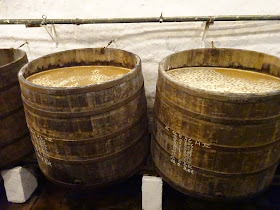Being back in Pilsen all I had to do was walk across a bridge to get to to the Plzeňský Prazdroj or Pilsner Urquell brewery. Someone in the group still managed to be late, but he was young enough to still enjoy the glory of oversleeping so it wasn't all bad for him.
We were met by the head brewer.
And a former head brewer who gave a talk for us before the tour. In a glorious bit of non-native English he said they had more of the sample beer than they could drink so we should go "full gas" when it came to drinking.
Unlike
last time I was there we got to see the maltings. They only make Pilsner malt, no calling it extra-pale or lager malt here, with a Kolbach index of 36-37 (that's on the low side). They produce 88,000 tonnes per year, enough for all the breweries on site (as well as PU there's Gambrinus and the Proud microbrewery) and Velké Popovice.
They have two steeps at 15°C over 28 hours where the moisture rises from 13-14% to 42-45%. There will be an air rest between the two steeps so the embryo in the grain can breathe. There are eight Saladin boxes with a capacity of 212 tonnes where the barley spends six days at 15-18°C. It's turned six hours after steep out and then usually every 12 hours. There are three kilns and they're all used for each piece (batch). Kilning takes 16-17 hours with a final temperature of 75-80°C. After 21 days the malt goes to the breweries.
The barley variety is the Spring barley Bojos.
 |
| A maltster and a Saladin box. |
Then it was packaging. Lots of big machinery and bottles moving around at unfeasible speed. There are two bottling lines at 60,000 bottles per hour, a canning line at 60,000 cans per hour and a canning line at 40,000 cans an hour for specialist products (!). The bottling lines have 168 head fillers.
They flash pasteurise most products, though there's a tunnel pasteuriser for some speciality products. They mostly pack in returnable 500ml bottles so there's a bottle washer. The turn around time for bottles is around one to two months. Some 330s are filled, and some recycled cans are used. Brown bottles are used for US and UK export, the rest are in "UV protection" green bottles. Beer is carbonated to 5g/l (2.5 vols)
Next we went to see the filters. They have a kieselguhr candle filter and two 72 module cross flow filters which filter 600hl/hr of high gravity beer down to 0.45 micrometres. The filter modules are changed after 400 CIPs. Pentair is paid a fee for them by hl filtered. The cross flow filters are better quality than the kieselguhr filter but cost more.
There's also a PVPP filter.
 |
| Cross flow |
 |
| Candle |
Unlike in brewing fermentation followed after filtration for us. They have 30 x 2500hl and 40 x 800hl cyclindroconical fermenting vessels and the maturation tanks are 56 x 3200hl and 28 x 5000hl CCVs. They ferment from 6° to 9°C for 14 days and mature for 20 days at 0°C (+/-1°C). Cooling is based on the PG (Present Gravity) of the beer not the diacetyl level, which is 85ppb in pack. They have 76-77% apparent attenuation and gravity drops 0.2°P (0.8°S) during maturation.
As you might expect there were lots of pipes and automated mix proof valves.
 |
| One's gone red |
Our hosts were thorough so se even got to see the cooperage:
And then be got to the brewhouse. Or rather brewhouses, this is the old, disused one:
There used to be 30 sets of vessels.
This is the new brewhouse:
 |
| Wort kettles |
10.5m diameter lauter tuns and 10.5 tonnes of malt per batch. Loading is 150kg/m2 and lautering takes 2.5 hours. OG is 12.2°P (1.049). |
| mash kettles |
Brewlength is up to 625hl. They do 24 x 600hl brews per day, running 24/7 making 5.2 million hl a year. Saaz/žatec, sladek and premiant hops are used. There three additions at the start of the boil and 60 and 80 minutes in to it. From which I'm going to infer it's a 90 minute boil.
Then it was into the cellars, there are 9km of them.
Some beer is still fermented in open wooden fermenters and matured in wooden barrels, which I guess keeps the coopers in work. We're told they do this to ensure that the taste isn't different from when it's made in the modern vessels. I don't believe a word of this myself, firstly because fermenting and maturing in giant CCVs is definitely going to make a difference and secondly because it does actually taste different. I didn't notice any diacetyl and the bitterness came through a lot more. Lovely it was. Sadly we were running late so didn't get to go "full gas" on the beer which is a shame.
If you want to look at the fermentation profile in wooden vats here it is:
They use their own lager yeast strain which is used for four generations.
As to the famous Pilsner water I'm not entirely sure what they do with it. We weren't with anyone technical when water was discussed and though I can't fault our tour guide's English I'm not sure about his technical knowledge. He said the water has its iron removed so it is deionised. Which left me confused. Was it iron or ions? Probably the former I would guess from something we learnt later in the study tour, and Pilsen water is famous low in ions anyway.
After all this we went to the onsite microbrewery but I'll leave that for later...




























